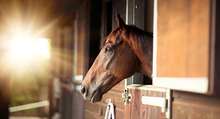
How to care for a horse on box rest
Caring for a horse on box rest can be stressful, especially during the summer when you both want to be out enjoying the warmer weather. Petplan Equine veterinary expert Gil Riley has some advice on how you can help your horse stay comfortable during this time.
Looking after a horse on box rest can be challenging and requires careful management to maintain his physical and mental wellbeing. As Gil explains, owners should be alert for signs of colic, respiratory problems, and filled legs and act to prevent such problems occurring.
Keep the air clean
If there is insufficient ventilation in the stable, or he already has a dust allergy, respiratory problems – such as coughing, nasal discharge and wheezing – could be a problem. ‘Many shavings vary in their dust quantity – even some of those that are purportedly dust-extracted,’ says Gil. ‘Ensure the bedding is truly dust-extracted, or bed on woodchip or cardboard, which are much less likely to be dusty.’
Check for swelling
Restricted movement can inhibit fluids returning from the limbs, meaning your horse’s lower limbs can swell up when on box rest. ‘Stable bandages are an excellent way to prevent the limbs from filling and should be used, especially overnight when there will be no prospect of a short amble,’ says Gil. ‘Stable bandages are essential for horses that cannot leave the box at all, for example those recovering from fractures.’
If your vet allows your horse to be walked in-hand for short periods several times a day, this can help swelling go down. However, hand-walking is not always easy as box rest can lead to changes in a horse’s behaviour.
Create a calm atmosphere
If your horse exhibits dangerous behaviour, Gil advises: ‘Consider whether it would be better to livery your horse at a professional yard where experienced handlers will be able to manage him safely.
‘There is the possibility of using oral sedatives to keep him calm – usually a morning and evening dose is sufficient. Use a bridle or even a correctly fitted chifney bit, as this provides a more secure hold on a distressed horse than a headcollar.’
If your vet permits it, rather than stable rest, you can fence off a tiny stable-sized paddock. ‘Some horses will settle much better in these,’ says Gil.
If stabling is the only option, Gil cautions against bedding a horse on straw, saying: ‘Eating lots of coarse bedding can cause an impactive colic. Ensure bedding is inedible and that fresh, clean water is available 24/7.
‘Double-net the horse’s forage to increase the length of time required to eat, and ensure plenty of good-quality, low-calorie chaff to keep the intestines ticking over. Low-calorie chaff is a forage substitute, not a hard-feed substitute, so you can feed it by the bucketload, not the handful, which means you can keep your horse busy with food.’
Stay busy
Being ‘busy’ is key, as boredom can cause a horse on box rest to exhibit vices such as box-walking, crib-biting, wind-sucking and swaying. Separation anxiety in horses is also something to consider if your horse is on box rest. Gil suggests keeping another horse in with the unwell horse to keep him company.
‘This is one of the best ways to prevent boredom, especially if the companion is a friend of your horse,’ he says. ‘Nut-dispensing footballs can also be popular with some horses, or horse treats you could hang from the ceiling to give him something to nuzzle and lick at.’
There are also a number of stable toys for horses marketed as horse boredom busters. ‘Mirrors are also worth trying as they make the horse feel like he has company,’ advises Gil. ‘Some horses seem happy to look at themselves for long periods.’
Entertaining horses on box rest isn’t easy. Some horse owners recommend playing a radio, or better still, says Gil: ‘Try to keep the horse in the barn that features the most human activity, to minimise boredom.’
Grooming a horse on box rest emulates mutual grooming that he would do if out with another horse. Massaging a horse also has benefits, as Gil says: ‘Contact with the person is the really important thing, and a massage is generally well received and can assist with movement of tissue fluid from the limbs back into the body.’
‘How I cared for my horse on box rest’
Horse owner Laura Buckle faced months of box rest for her horse, Gemini, when the mare fractured a bone in her front left leg. After several weeks in her stable, Gemini became aggressive, kicking out and trying to escape.
Laura recalls: ‘One day, Gemini managed to break under the stall guard. She trotted off down the driveway to the yard. She broke into a canter and bucked as she went past me. We were just weeks away from the next X-ray.
When I got her back in the stable, she turned and aimed a kick at me, pinning me against the wall. I felt like I couldn’t cope much longer and remember shedding more tears wondering if my placid, kind and caring mare would ever return.’
Many owners will relate to the feeling of exasperation Laura experienced while trying to do the best for her horse. But there was a happy ending in this case as, after six months of careful rehabilitation, Laura was able to slowly bring her mare back into work and eventually start turning her out again.
‘She has returned to jumping, which has been the best news,’ says Laura. ‘At her first competition in September, she was placed with my instructor in both dressage and combined training. We have had a few hiccups along the way, but Gemini is now back on track and I am enjoying having my placid, caring mare back.’


